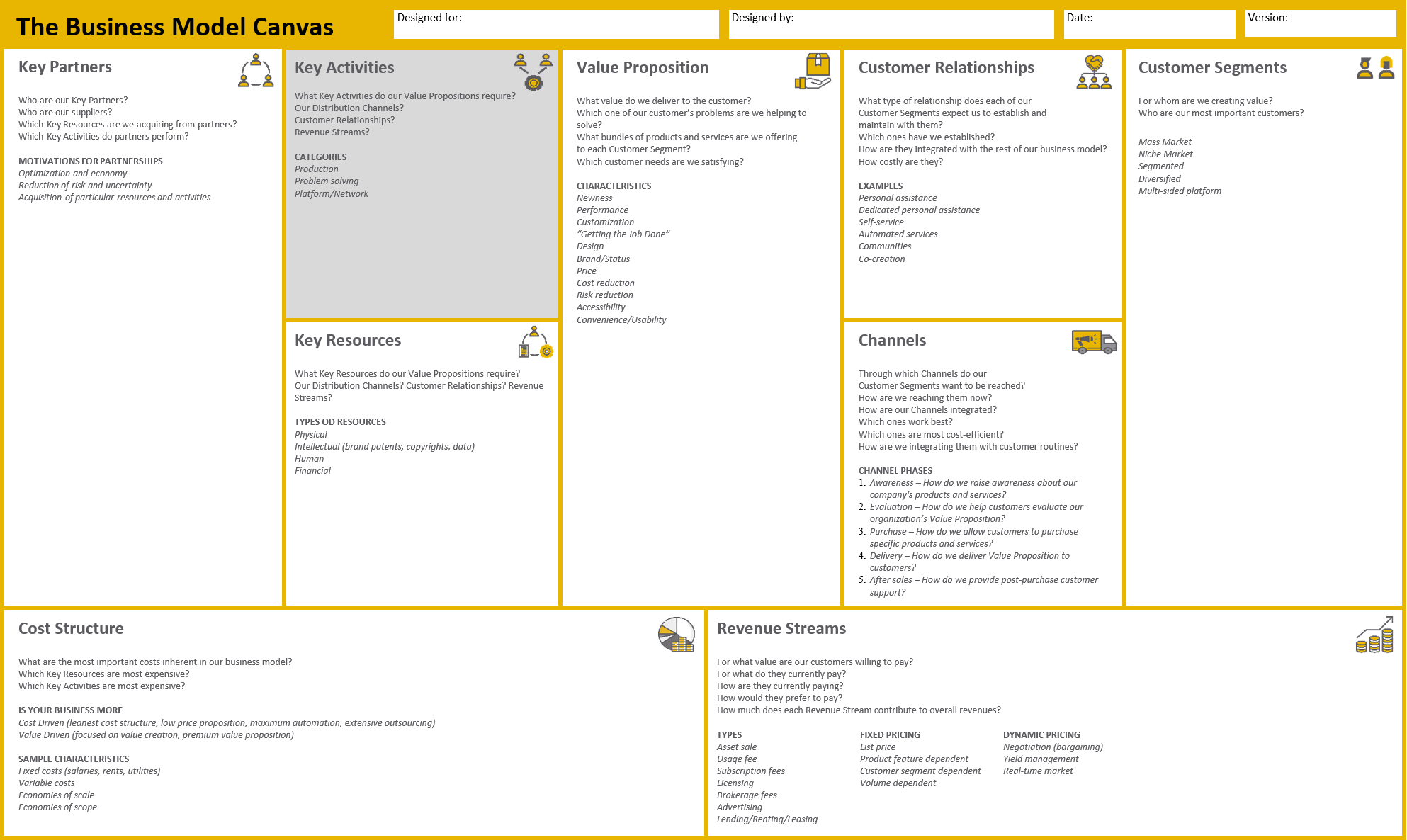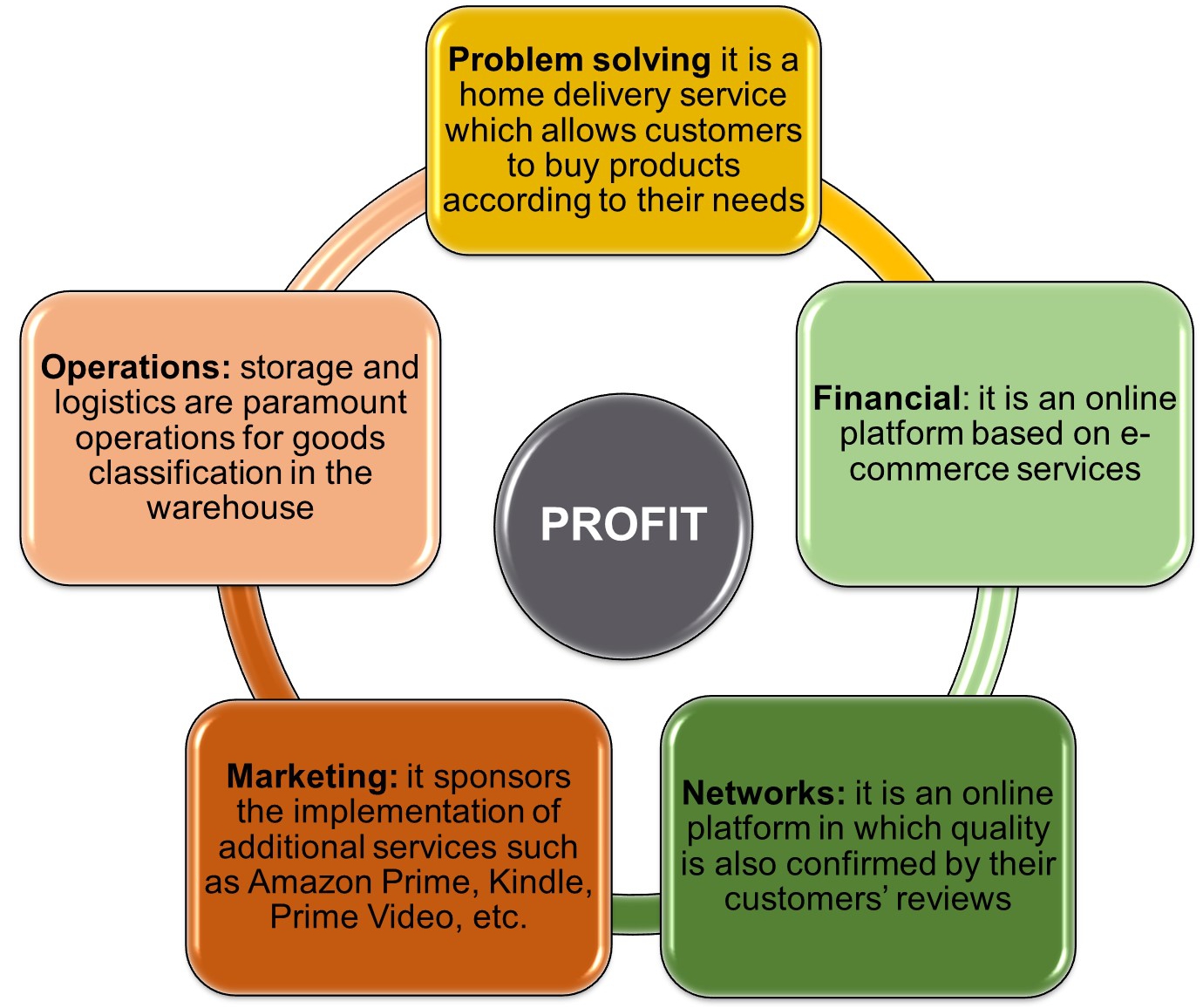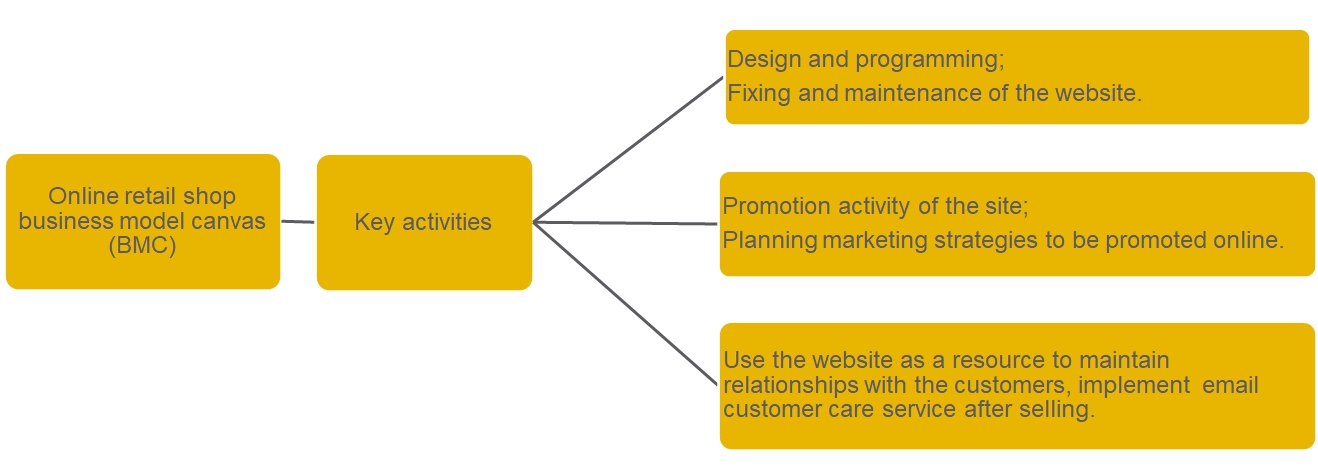Module 8
KEY ACTIVITIES
The purpose of this module is to enable better understanding of the Key Activities segment in the business model canvas and to work with it in a business plan.



Key activities
Introduction
Every manager should be engaged in the creation of a Business Model Canvas, especially in setting the primary key activities as they are fundamental to reach the expected goals. Business activities include taking decisions in terms of operations, administration, production, problem-solving, marketing and communication activities across customers.
Key activities cannot be uniform, as they change according to the type of activity and operation performed. Consequently, once set they adhere to the company’s needs and future objectives. Before setting key activities, managers should make an internal audit: valuing their own means of production, problem-solving activity, platforms, and networks and giving importance to the rapport they have with customers, with whom they are communicating the value proposition of their product.
Purpose
The purpose of this module is to enable better understanding of the Key Activities segment in the business model canvas and to work with it in a business plan.
Learning Outcomes
After the completion of this module the learner will be able to:
-
- define the concept of Key Activities within the business model canvas;
- list the main Key Activities within an enterprise;
- list the relevant Key Activities to required to reach the objectives and purposes of an enterprise;
- illustrate the importance of Key Activities in the definition of the value proposition;
- explain the relationship between Key Activities and the value proposition of an enterprise;
- focus only on certain Key Activities, in line with the value proposition.
Keywords
-
- key activities
- differentiation
- customers
- value proposition
- expected goals
- competitors
The relevance of key activities
-
- Key Activities describe what an enterprise does, which key actions are carried out within the organization to fulfil and create long-term revenue streams.
- Assessing the Key Activities includes starting from an internal analysis. Managers should ask themselves: Which activities are necessary for a good value proposition?
- The Key Activities should be focused on unique value creation.
Key Activities consist of the main actions performed by an enterprise for the primary purpose of making a profit.
When defining an enterprise’s key activities, the following questions may be useful:
-
- What are the most important actions required to build a product / service?
- What is the most important element to distribute a product / service?
- What activities could support maintaining the customer relationship (service, experience, etc.)?
- What activities are fundamental to customer streams? (trust, credit limit, fast payment)
Theoretical background
In the business model canvas (BMC), the Key Activities a company performs can be expressed in the areas: operations, marketing, production, problem solving, networks, financial (or administration). In the next slide each area is explained in depth.

BMC template and key activities description
-
- OPERATIONS: the internal working process of the company.
- MARKETING: promotions, campaigns, advertisements, channels to promote the value proposition.
- PRODUCTION: linked to the main operations to produce the value proposition, e.g. designing, manufacturing.
- PROBLEM SOLVING: study metrics, training for improvements.
- NETWORKS: where the company might reinforce a closer contact with customers, e.g. use of ICT and social media.
- FINANCIAL: merchant accounts, e-commerce stores
Key activities and subcategories
These areas are very important as they ensure the growth of the company. It is therefore necessary to make sure they are running and are diffused across the organization.
Depending on the activity of a company, certain activities prevail over others, e.g., financial companies will be more involved in problem-solving activities rather than production.
Key activities can be therefore divided into 4 subcategories:
| Core activities | Primarily related to the generation of the output. |
| Support activities | Are related to the output production (e.g., record-keeping). |
| Coordination activities | Ensure the alignment in the degree of integration between core and support activities (e.g., account management) |
| Strategic activities | Assess the alignment and need for changes, are related to the outside environment (e.g., distribution channels, customer relationship etc.) |
Key Activities for the Business Model Canvas
After having considered the previous categories, two major key activities should be given importance when working on the business model canvas:
-
- Supply Chain Management – this aspect comes into play with the identification of key partners and key resources. The supply chain management should become paramount in the organization, in order to ensure you are working with your key partners to produce the best value proposition.
- Software Development – software processes have digitalized the systems of many companies. Computer software helps to manage all the pieces of a business that need to operate and run. Significant consideration should be given to whether the processes should be internal or external and which partnerships should be established.
Examples and Good practice
Example – café
If you are starting a hole-in-the-wall café, you have to make sure you are developing the necessary key activities. These include:
|
 |
 |
Some important considerations
Analysing your means of production, problem-solving, and platforms or networks are important considerations to define your key activities.
When defining the key activities, the ultimate goal is to help you discover what activities you need to address in order to differentiate your value proposition or service from that of the competition. This is important in order to adequately deliver your value proposition. When considering the key activities block, in terms of key processes and activities, take into account your key resources and partners in order to progress towards the next steps contained within the business model canvas, since they are all interwoven.
For example, key activities are, on the Business Model Canvas, the bridge between the value proposition and the customer segments, so you ought to be customer-oriented when moving towards the customer relationships block.
| Key activities should be frequently revised. If you take the example of Netflix, the company started its activity with the distribution of DVDs. The company has since moved way ahead of this situation, switching its key activities towards the creation of new content. |  |
Questions for Reflection
-
- How can you identify your key activities? Focus on the suggested list.
- Define your strategic activities. Your company will engage in a series of processes and activities in order to work properly, however, not all of them are strategic.
- Think about the Business Model Canvas and focus on your key resources and your key partners. Identify the elements that link them to your business idea, since they will highlight what your key activities are.
- Keep it simple and do not over think. Start from your value proposition and think about your area of competence. What is your most prominent area among the following ones: operations, marketing, production, problem solving, networks, financial?
Example – Amazon Key Activities
|
 |
Example – key activities for e-commerce
In a retail e-commerce store, the company’s key activities will be mainly focused on the maintenance of the website:

Key activities in Research and Development
Key activities depend on the primary activity of the company.
Research and development is a key activity which is often ignored, but it becomes of paramount importance for cosmetics companies or ICT companies, since it liaises with activities related to design, production and sales.
For this reason, these companies should focus on the following key activities:
-
- Production: including the design, development and launch of new products or platforms/services. This is the main key activity of these enterprises.
- Marketing: sponsor and promote the renewal of the products/services.
- Financial: linked to e-commerce services and accounting.
Production and core activities in Research and Development
By linking production to research and development, the analysis of an enterprise’s key activities may be further developed into the following core activities:
-
- Product Research: Before the production of a new product, it must first go through the research and development department which will evaluate what customers expect from it, production costs, etc.
- New product: It underpins the production of a completely new output.
- Product Updates: R&D must consider upgrading of products, depending on evolving consumer needs or new value propositions of entrants into the market. Updates aim at solving glitches related to products.
- Quality Checks: Companies conduct quality checks or ask their quality assurance team to evaluate whether all products are up to the quality standards set by the company.
- Innovation: The R&D department is responsible for monitoring new trends and for the innovation of products in an attempt to ensure that their products stay abreast of current trends.
Example – LinkedIn Key Activities
LinkedIn is the best-known professional network for job searches and related activities. Over the years it has created a value proposition targeted towards consumers, with a high focus on sharing / providing working capabilities and opportunities for both employers and workers.
According to the six key activities, LinkedIn prioritizes networks, since it is a social network, and the platform development represents its main goal, which is to build a professional community.
-
- Manage professional profiles and CVs and build a robust professional network;
- Connect source and target groups through its job offer function to reach the right talent;
- Communication with the right audience;
- API and Widgets (systems providing functionalities like texting, live chatting);
- Continuous innovation for the platform development
References and External Links
-
- Wealth Builders, Developing Key Activities: Business Model Canvas
https://wealthbuilders.org/blog/2015/03/30/developing-key-activities-business-model-canvas/
[consulted 13/07/2020] - Cleverism, Key Activities Block in Business Model Canvas
https://www.cleverism.com/key-activities-block-business-model-canvas/
[consulted 13/07/2020] - Business 2 Community, Key Activities and Your Business Model
https://www.business2community.com/strategy/key-activities-and-your-business-model-02232678
[consulted 14/07/2020] - Denis Oakley, What is the Amazon Business Model?
https://www.denis-oakley.com/amazon-business-model-canvas/
[consulted 14/07/2020] - Heflo, Understand the Key Activities in the Canvas Model
https://www.heflo.com/blog/business-management/key-activities-business-model/
[consulted 16/07/2020] - Osterwalder, A., Pigneur, Y., In Clark, T., & Smith, A. (2010). Business model generation: A handbook for visionaries, game changers, and challengers.
- Strategyzer Support, How do I use the Customer Segments building block of the Business Model Canvas?
https://strategyzer.uservoice.com/knowledgebase/articles/1194379-how-do-i-use-the-customer-segments-building-block - Shopify, Business Encyclopedia
https://www.shopify.com/encyclopedia/customer-segmentation - CrashCourse, Value Proposition and Customer Segments: Crash Course Business – Entrepreneurship #3
https://www.youtube.com/watch?v=m2IPvT920XM
- Wealth Builders, Developing Key Activities: Business Model Canvas
Copyright @2021 – businessmodels.eu


